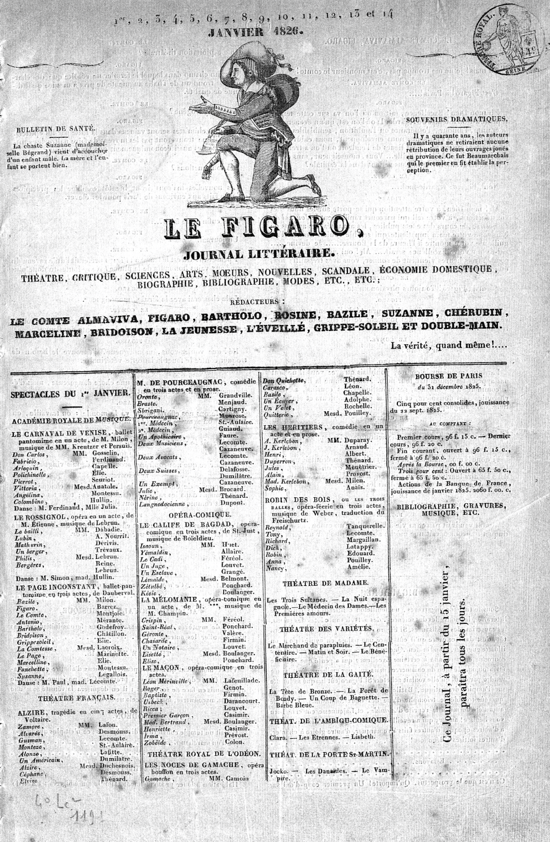 |
| Le Figaro logo 1826 |
Name: "Le Figaro"
Category: Newspapers
Founders: Maurice Alhoy, Étienne Arago
First issue: January 15, 1826 - Paris, France
First editor: Auguste Lepoitevin Saint-Alme
First format: 4-pages folio
First price: In 1826 the subscription price to "Le Figaro" was 1 month 6 French francs, 3 months 15 Fr., 6 months 30 Fr., 1 year 60 Fr.
Overview: "Le Figaro" was named after the character in the trilogy by Pierre-Augustin Caron de Beaumarchais (Le Barbier de Séville, Le Mariage de Figaro, La Mère coupable). It is the longest French newspaper and one of the oldest in the world. Its founders were Maurice Alhoy (Paris 1802 - Apr. 27, 1856), journalist, writer and playwright, and Étienne Arago (Perpignan, Feb. 9, 1802 - Paris, Mar. 7, 1892), playwright and politician. Le Figaro, a tiny four-page journal printed on the cheapest paper, was born on January 15, 1826. In April the journal is led by Auguste Lepoitevin Saint-Alme (first contributor of Balzac and founder of Corsaire and the Corsaire-Satan); from 1827 to August 1830 by Victor Bohain (businessman, linked with Balzac too) and from 1830 to January 1834 by Henri de Latouche (another friend, author of a novel, Fragoletta). After nine years from its first edition, the original Le Figaro ceases publication: the last edition was the No. 335 published on December 1, 1834. After thirty years, the journalist Hippolyte de Villemessant relaunches Figaro as a weekly newspaper: first issue April 2, 1854. The newspaper is mostly Parisian and literary. Hippolyte de Villemessant immediately surround himself with talented writers (Balzac, Baudelaire, Alexandre Dumas and the Goncourt brothers) and innovates: it creates permanent sections in which readers find themselves, and inserts short news, obituary and letters to the editor. He also inserts the "Echoes", which made the success of the newspaper, with puns, anecdotes, indiscretions and gossip. On January 6, 1856, the newspaper becomes biweekly and then appears Wednesday and Sunday. In 1866 Le Figaro become a daily newspaper. Its first daily edition, that of November 16, 1866, sold 56,000 copies, having highest circulation of any newspaper in France.
Motto (1826): «La vérité, quand même !....» - "The truth anyway!...." (particularly challenging, because it diverts the motto «Vive le roi, quand même» - "Long live the king, anyway!")
 |
| Le Figaro, header of the first issue (No. 1 - January 15, 1826). Figaro is shown as it appears in the first act of Le Barbier de Séville: a smiling young man in search of inspiration, with one knee on the ground and the other as a support to write. |
 |
| Le Figaro, front page of the first issue (No. 1 - January 15, 1826). Date: «1er, 2, 3, 4, 5, 6, 7, 8, 9, 10, 11, 12, 13 et 14 Janvier 1826» (a note on the bottom right warns: «Ce Journal, à partir du 15 janvier, paraitra tout les jours» - "This newspaper, from January 15, will become daily"). Title: «Le Figaro, journal littéraire. Théâtre, critique, sciences, arts, moeurs, nouvelles, scandale, économie domestique, biographie, bibliographie, modes, etc., etc.;» - "Le Figaro, literary journal. Theater, criticism, science, art, customs, news, scandals, domestic economy, biography, bibliography, fashion, etc., etc". The editors are listed as the characters in the play of Beaumarchais: «Le comte Almaviva, Figaro, Bartholo, Rosine, Bazile, Suzanne, Chérubin, Marceline, Bridoison, la Jeunesse, l'Eveillé, Grippe-Soleil et Double-Main». In December 1934 the original Le Figaro ceases publication. |
 |
| Le Figaro, header of the new weekly edition (No. 1 - April 2, 1854). Below the figure, the motto «Loué par ceux-ci, blâmé par ceux-là, me moquant des sots, bravant les méchants... je me presse de rire de tout, de peur d'être obligé d'en pleurer. (Barbier de Séville)» - "Praised by them, accused by others, making fun of fools, braving the bad guys... I must force myself to laugh at everything lest I be obliged to weep. (Barber of Seville)". Below the title, «Journal non politique» - "Apolitical newspaper". |
 |
| Le Figaro, front page of the new weekly edition (No. 1 - April 2, 1854). On January 6, 1856, the newspaper becomes biweekly and then appears Wednesday and Sunday. |
 |
| Le Figaro, front page of the new daily edition (No. 1 - November 16, 1866) |
 |
| Jean Hippolyte Auguste Delaunay de Villemessant (Rouen, April 22, 1810 - Monte-Carlo, April 12, 1879), the French journalist who revived Le Figaro on April 2, 1854, initially in a weekly format, than daily. |
 |
| Le Figaro in its advanced version (January 8, 2015 - terrorist attack on the French satirical magazine Charlie Hebdo) |



